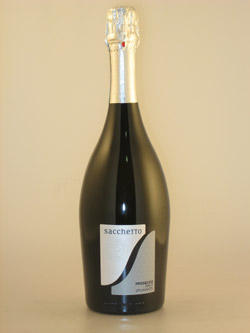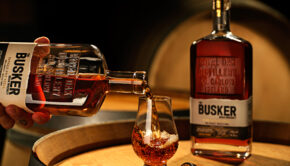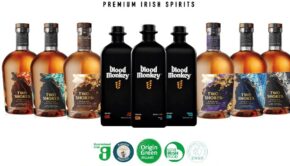Shelflife Tasting: Talking Prosecco
14 July 2010
 Across global markets sparkling prosecco is believed to have been mainly responsible for growing Italian wine sales by around 12-15%, in a year when virtually all other producer countries saw a drop in value and volume. On the Irish market it was one of the few wine styles to show growth in 2009, and it’s now an important category for off-licenses. Starting with the 2009 harvest, there have been some important changes in prosecco regulations and we’ve had quite a few enquiries from independents, wondering what’s happening and how they should explain things to customers.
Across global markets sparkling prosecco is believed to have been mainly responsible for growing Italian wine sales by around 12-15%, in a year when virtually all other producer countries saw a drop in value and volume. On the Irish market it was one of the few wine styles to show growth in 2009, and it’s now an important category for off-licenses. Starting with the 2009 harvest, there have been some important changes in prosecco regulations and we’ve had quite a few enquiries from independents, wondering what’s happening and how they should explain things to customers.
Here’s the story
As most of the wine trade is aware, the volume growth in prosecco has been very great in recent years, with around 150m bottles now produced annually. However, only around 60m come from the historic area of origin around Conigliano Valdobbiadene in Veneto and from specified districts in Friuli.
Fearing for the distinctive image of their historic wines, Conigliano Valdobbiadene, lobbied to be raised to the superior DOC level of DOCG (Denominazione Origine Controllata e Garantita) and this has now happened. It’s been joined by two other Prosecco DOCG areas- Asolo and Colli Asolani- while eight surrounding districts have been raised from regional IGTs (Indicazione Geografica Tipica) to DOC. Crop yield regulations have also been adjusted, with no more than 13.5 tonnes per hectare of grapes being allowed for DOCG wines and 18 tonnes for DOC. Producers on the top cru hill at Cartizze may only harvest 12 tonnes per hectare.
The changes have had an impact on labelling which retailers need to know about. From 2009 vintage, no prosecco from outside DOC/DOCG areas will be allowed carry the word prosecco on the label and the grape must be listed under its alternative name of glera. It is also no longer legal to label a product as prosecco rosé. Prosecco is a white grape and thus can’t have a pink version. These wines are blends and must be labelled as such. In the meantime the word rive may appear on fully sparkling (spumante) wines from the classic region. However, it’s also allowable to produce still (tranquile) and semi sparkling (frizzante) prosecco wines from the historic zone.
The legal situation is that all prosecco must contain at least 85% prosecco grapes with up to 15% of other specified varieties. These are mainly verdiso, which contributes acidity, and pinot blanc which generally adds extra power and weight. All DOC prosecco must be packaged in glass bottles; this seems to have been a reaction to a recent promotion in which Paris Hilton was pictured drinking prosecco from a can!
It’s a tricky situation for retailers who will have the task of explaining to customers why their favourite prosecco, if it comes from outside the historic zone, is the same wine but now with a different name. On the whole, though, the new rules should be good for consumers, making it easier to identify authentic, high quality wine. It will encourage DOC producers to work towards consistent quality; let’s hope they don’t become over ambitious about pricing. It’s not expected that the rule change will impact on global sales, which are expected to continue growing in the near future. Here are some examples from the DOC zones with decent value. Prices are approximately trade; as usual these days, it’s worth looking for deals from suppliers, but in this category they could be scarce as demand for the wines is holding so well.
Bisol Jeio Prosecco di Conigliano DOCG. Fine acidity and green fruit flavours make this a lovely, special occasion aperitif and first course wine(Searson €13.40).
Valdo Marco Ora Prosecco DOCG (Febvre €13.50). Slightly more aromatic style, with some peach and floral notes. Great summer aperitif.
Fantinel Prosecco DOC (Cassidy €12.50). The vineyards of this Friulian maker are just two miles from the original home of the grape and the wine is now DOC. Zesty stuff, with floral and apricot aromas and hints of lemon and lime on the palate.
 Ca Morlin Prosecco dei Colli Trevigiani DOC (Liberty €8.50). This is from one of the districts that has been raised from IGT to DOC. Softer style that doesn’t pretend to be a Champagne substitute; appealing apricot aromas make it an easygoing aperitif, perfect with canapes.
Ca Morlin Prosecco dei Colli Trevigiani DOC (Liberty €8.50). This is from one of the districts that has been raised from IGT to DOC. Softer style that doesn’t pretend to be a Champagne substitute; appealing apricot aromas make it an easygoing aperitif, perfect with canapes.
La Tordera Prosecco dei Colli Trevigiani DOC (Taserra €12.50). Another light style but with lively peach fruits and low alcohol.
Drusian Proseccoo di Valdobbiadene DOCG (Quintessential €14). Refreshing palate of lemon and green fruits; good length and intensity make it a great special occasion bubbly.
Borgo Molino Prosecco DOCG Extra Brut (Italicatessen €11.50). Zesty style, with green apple and pear character. Good aperitif and with nibbles.
Bortolomiol Prior Prosecco di Valdobbiadene DOCG (Mitchell €13). Green fruit, citrus and soft yet balancing acidity make this ideal for vegetarian dishes and salads as well as aperitif. The same house has a frizzante from Trevigiani, which is only around ?11.50 retail and makes a lovely, quite fruit driven, summer drink.
Nino Franco Prosecco Rustico Prosecco di Valdobbiadene DOCG (Nicholson €13). This is very slightly off dry and has soft aromas of apricot and peach. If you don’t mind drowning out a tasty wine with dollops of fruit juice, then it is the perfect base for a Bellini.
Sachetto Prosecco Frizzante di Colli Trevigiani (Cassidy €7.50). Sprightly party popper at the right price; serve in sunshine with nibbles.




 Print
Print






Fans 0
Followers